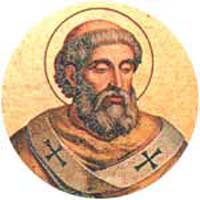To protest the emperor, he paid special honor images and relics
Pope St. Gregory III
(Reigned 731-741.)
 Pope St. Gregory III was the son of a Syrian named John. The date of his birth is not known. His reputation for learning and virtue was so great that the Romans elected him pope by acclamation, when he was accompanying the funeral procession of his predecessor, 11 February, 731. As he was not consecrated for more than a month after his election, it is presumed that he waited for the confirmation of his election by the exarch at Ravenna. In the matter of Iconoclasm, he followed the policy of his predecessor. He sent legates and letters to remonstrate with the persecuting emperor, Leo III, and held two synods in Rome (731) in which the image-breaking heresy was condemned. By way of a practical protest against the emperor’s action he made it a point of paying special honour to images and relics, giving particular attention to the subject of St. Peter’s. Fragments of inscriptions, to be seen in the crypts of the Vatican basilica, bear witness to this day of an oratory he built therein, and of the special prayers he ordered to be there recited.
Pope St. Gregory III was the son of a Syrian named John. The date of his birth is not known. His reputation for learning and virtue was so great that the Romans elected him pope by acclamation, when he was accompanying the funeral procession of his predecessor, 11 February, 731. As he was not consecrated for more than a month after his election, it is presumed that he waited for the confirmation of his election by the exarch at Ravenna. In the matter of Iconoclasm, he followed the policy of his predecessor. He sent legates and letters to remonstrate with the persecuting emperor, Leo III, and held two synods in Rome (731) in which the image-breaking heresy was condemned. By way of a practical protest against the emperor’s action he made it a point of paying special honour to images and relics, giving particular attention to the subject of St. Peter’s. Fragments of inscriptions, to be seen in the crypts of the Vatican basilica, bear witness to this day of an oratory he built therein, and of the special prayers he ordered to be there recited.
Leo, whose sole answer to the arguments and apologies for image worship which were addressed to him from both East and West, was force, seized the papal patrimonies in Calabria and Sicily, or wherever he had any power in Italy, and transferred to the patriarch of Constantinople the ecclesiastical jurisdiction which the popes had previously exercised both there, and throughout the ancient Prefecture of Illyricum.








